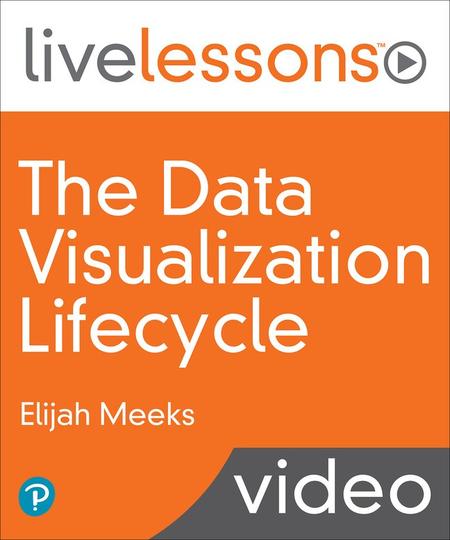
English | MP4 | AVC 1280×720 | AAC 44KHz 2ch | 34 Lessons (3h 57m) | 1.18 GB
The Perfect Course for Learning the Data Visualization Life Cycle
The Data Visualization Life Cycle not only teaches you fundamentally useful techniques for making your data visualizations better, but it will also open your eyes to the different data cultures that exist in our modern, data-driven world. You learn how to make better data visualization for your stakeholders, work more effectively with your peers, and enhance your ability to explore your own data.
Learn How To:
- Understand your audience and the approach you should take to your data visualization
- Optimize data visualizations for different data cultures and points in the life cycle
- Collaborate with others to produce data visualizations
- Manage pain points when working with different data professionals
- Improve data explanation
- Design for different kinds of data products and delivery methods
- Build a data visualization culture and increase data literacy
- Investigate automated and machine-based analysis
- View data visualizations as business assets
Lesson 1. Understanding Stakeholders and Approaches to Data Visualization
Data visualization is often taught as if there was only one kind of approach to answer one kind of question for one kind of audience. But data visualization out in the real world is used in many different ways with different goals and different ways of measuring impact. In this section, I introduce the data visualization life cycle, which will provide you with a broader understanding of different approaches to data visualization.
Lesson 2. Optimizing for Different Data Cultures
Its not enough to understand that there are different ways of doing data visualization from a theoretical standpoint. This section focuses on specific and practical aspects of how you might visualize the same information differently depending on where you and your audience are in the data visualization life cycle. We focus in on how to visualize data for data wrangling, data engineering, and data science.
Lesson 3. Collaboration Foundations
Collaboration isnt well-described in a data visualization setting, even though it happens all the time. In this section, we explore how different roles collaborate with each other as well as how principles of collaboration help you to design charts even if the audience is only yourself. To understand collaboration, we look at it from several different angles including collaboration between data roles to make a product, collaboration with stakeholders, and how to think about collaborating with yourself.
Lesson 4. Collaboration in Mature Data Organizations
Once youve mastered the general principles of collaboration you need to understand how we collaborate in more mature data settings. This section highlights typical modes of collaboration in organizations with different data roles by looking at each data roleanalyst, data engineer, and data scientistto understand typical areas of friction between the roles to develop a data visualization product.
Lesson 5. Improving Data Explanation
When your data visualization is used for explanatory purposes you need to leverage all the features available to you to make the most actionable charts. This section provides you with an overview and specific examples of how to make your data visualization more informative and accessible but also more likely to be used and acted upon.
Lesson 6. Productization Productionalization Productischemizationismeizen
Sometimes we view charts in a dashboard, sometimes in an email report, and sometimes using interactive scrollytelling. This section details the affordances and tradeoffs of each of these modes with tips and techniques to ensure that youre using the right mode and taking advantage of its strengths.
Lesson 7. Closing the Loop
We often think that charts only exist for a single decision, but they live on and affect more than just the moment they were made for. In this section, we explore how charts live on in an organization and what it means for you, your team, and your organization. Understanding this not only lets you make more effective charts but also makes for a more effective organization by growing data literacy and developing long-term processes that lead to better data visualization and better results from that data visualization.
Table of Contents
Introduction
1 The Data Visualization Lifecycle Introduction
Lesson 1 Understanding Stakeholders and Approaches to Data Visualization
2 Topics
3 The lifecycle relies on “It Depends”
4 How your role aligns with the lifecycle
5 Exploring versus explaining in the lifecycle
Lesson 2 Optimizing for Different Data Cultures
6 Topics
7 Where are you in the lifecycle
8 Visualizing the data by cleaning it (data wrangler culture)
9 Visualizing the data by understanding its health and performance (data engineer culture)
10 Visualizing data with hypothesis generation and exploration (data scientist culture)
Lesson 3 Collaboration Foundations
11 Topics
12 Typical pain points in presenting to data consumers
13 General principles of collaboration with data visualization
14 General versus specific approaches to data visualization
Lesson 4 Collaboration in Mature Data Organizations
15 Topics
16 Differences between young and mature data organizations
17 Typical pain points of engineer to analystdata scientist handoffs
18 Typical pain points of scientist to analyst handoffs
19 Typical pain points of analysts working with data scientists and engineers
Lesson 5 Improving Data Explanation
20 Topics
21 Storytelling
22 Growing your audience
23 Interactivity (data apps)
24 Building and spending trust with your stakeholders
Lesson 6 Productization
25 Topics
26 Chart design for self-service versus curated data products
27 Optimization for using different delivery methods (dashboards, reports, memos, scrollytelling)
28 Data visualization as metric design (data visualization as part of the virtuous cycle of data)
Lesson 7 Closing the Loop
29 Topics
30 Building your data visualization culture
31 Increasing data (visualization) literacy for your organization
32 Explanatory techniques useful for automatic exploratory analysis (anomaly detection, intelligence)
33 Data visualization as business assets
Summary
34 The Data Visualization Lifecycle Summary
Resolve the captcha to access the links!